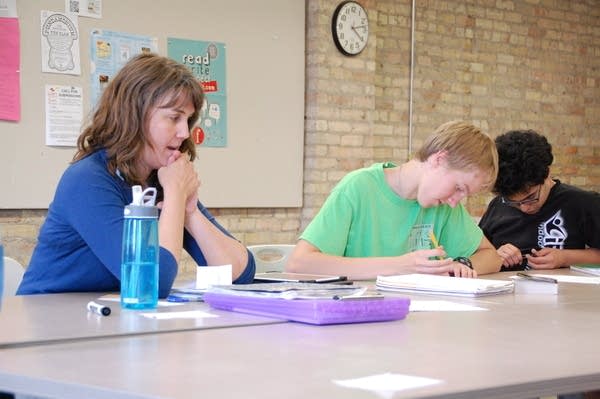Teachers say digital technology helps and hurts student writing
Go Deeper.
Create an account or log in to save stories.
Like this?
Thanks for liking this story! We have added it to a list of your favorite stories.

A recent survey says social media has given students a new outlet for their writing.
That's a good thing.
But what's not so good is the informal style and sloppiness of texting and social media that's finding its way into students' assignments.
Some Minnesota teachers have already figured out that they have to tell students to keep texting-speak out of their work.
Turn Up Your Support
MPR News helps you turn down the noise and build shared understanding. Turn up your support for this public resource and keep trusted journalism accessible to all.
Nicholas Yopp, who attended a writing class for high school-aged students recently at the Loft Literary Center in Minneapolis, has heard the warning.
"I think they have sloppy habits of mind, and I think that the Internet feeds into that."
"In my school, the teachers, before they give us any assignment," he said, "every one of them has made it very clear that you will get a very low grade if you put texting acronyms in there."
Sixteen-year-old Jorie Schwab from Grant, Minn., insisted she never uses texting shortcuts in her schoolwork.
But Schwab understands how other students slip up.
"I don't even know if they realize it when they're writing," she said. "But it's just such a part of their language that they just write it."
Kristen Purcell is director of the Pew Center's Internet and American Life Project.
The project recently surveyed nearly 2,500 middle and high school teachers across the country about the writing habits of students.
• Today's Question: Tell us what you think
• Daily Circuit: Teachers see little harm
"Some of that informal style and language does creep into [students'] formal writing," she said, "so that's something that [teachers] have to address with their students."
Most teachers 68 percent say use of the Internet and mobile technology leads students to take shortcuts in their writing.
That can show up as the occasional lowercase "i," or the lack of proper punctuation in an essay.

Mara Corey teaches Advanced Placement writing courses at Irondale High School in New Brighton, Minn.
Corey said she has seen a decline in students' writing skills over her 13 years of teaching.
"I think they have sloppy habits of mind, and I think that the Internet feeds into that," she said.
Students are writing constantly, she said, but chatting and texting just aren't as deep as conversation and prose.
Lee Cornell isn't sure the quality of student writing has slipped.
Cornell is an associate professor at Minnesota State University in Mankato. Before he was a professor, he taught middle school English in the 1970s and 1980s.
"Before, maybe in the Stone Age, people who wanted to write about their favorite movie or book weren't able to show people."
"If someone were to find 10 papers from each decade and throw them into a pile and ask people to sort them out, it would be really, really hard to say 'Oh this is so much better; this must be from the 90s,' or 'This is so much worse; it must be from the 2000s,''" he said.
But Cornell has noticed one big change in how students write: "The structuring of particularly longer papers is more difficult for current students." The Pew Center's survey of teachers found a few other concerns. Digital technology has made students more impatient with the writing process, and it's also made plagiarism more prevalent.
That said, the survey found plenty to be optimistic about when it comes to digital technology and students' writing.
For one: The internet has given students a bigger audience than they've ever had before.
For instance, said 15-year old Ann Leimbach from St. Paul: "Before, maybe in the Stone Age, people who wanted to write about their favorite movie or book weren't able to show people."
Now that we're out of the Stone Age, technology also provides places where students can collaborate — with their teachers or with each other — on their work.
Olivia Alger, a 14-year-old from Minneapolis, likes to work with other students using Google Drive, an online document-sharing site.
But Alger says even that tool has temptations that can lead to sloppy work.
"The downside to that is there is an option where you can chat — so it's kind of nice, but its really distracting," she said.
Despite the distractions, teachers says digital technology is making their students more creative. More than three-quarters (78 percent) surveyed said the Internet and social media have brought out more personal expression in their students.




